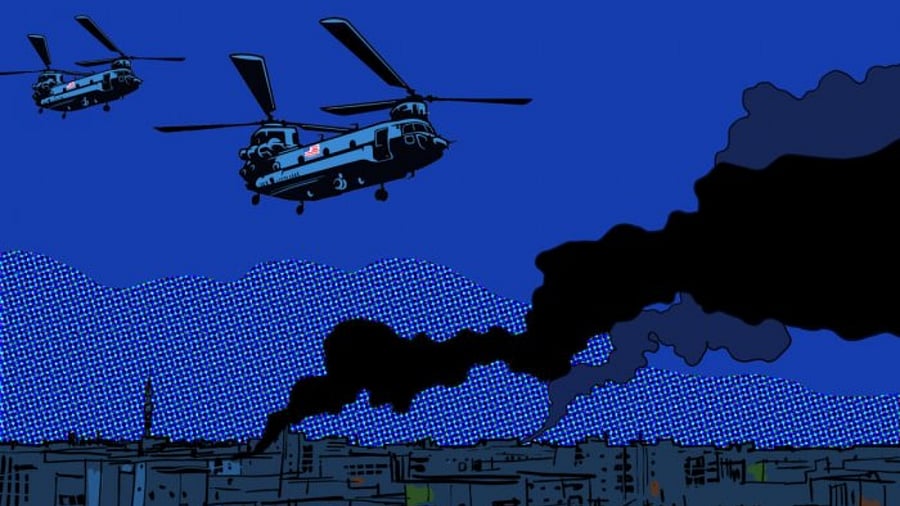
It began with a helicopter evacuation of American diplomats from Sudan’s besieged capital city just after midnight Sunday, then turned into a full-fledged exodus of foreign officials and citizens of other nations as the battle raged around them.
At the US Embassy in Khartoum, an elite team of Navy SEALs ushered up to 90 people onto aircraft before taking off for Djibouti, 800 miles away.
Hours later, a United Nations convoy began snaking its way out of the city, starting a 525-mile drive to Port Sudan on the Red Sea, while British and French diplomats were escorted to an airfield outside the city, where military cargo planes were waiting. Other groups headed for Qadarif, a small town near the border with Ethiopia, and a boat chartered by Saudi Arabia carried its fleeing diplomats across the Red Sea.
After days of fruitless diplomatic efforts to get two warring Sudanese generals -- Sudan’s military, led by Gen Abdel-Fattah Burhan, and the paramilitary Rapid Support Forces, led by Lt Gen Mohammed Hamdan Dagalo-- to lay down their weapons, foreign governments took another tack this weekend: fleeing a country, long viewed as strategically important, that has been in the grip of intense fighting for over a week.
Emotions were raw.
Some Sudanese, feeling angry and abandoned, lashed out Sunday at the Western negotiators they blame for the disastrous collapse of political talks that were supposed to lead to civilian rule — but instead became a flashpoint for the two generals now battling for power.
Foreign officials, some say, went too far to appease the generals, treating them nearly as statesmen when in fact the two men seized power in a coup and have long records of abuses and deception. Some Sudanese fear that now, the exit of foreign diplomats might allow an even more brutal turn in the nation’s affairs.
“You put us in this mess and now you’re swooping in to take your kinfolk (the ones that matter) and leaving us behind to these two murdering psychopaths,” Dallia Mohamed Abdelmoniem, a Sudanese former journalist and commentator, said on Twitter.
At least 400 people have been killed in the clashes and 3,500 injured, according to the United Nations, and two-thirds of the hospitals have closed. As prices soar, food is scarce and likely to become scarcer still; over the weekend, the country’s largest flour mill was destroyed in fighting. Even supplies of cash are running low.
With no end of the fighting in sight, concern is growing that a battle that has transformed Sudan with extraordinary speed might end up entangling other nations in the volatile region.
On Sunday, the cacophony of gunfire and bombs that has trapped thousands in their homes in the Sudanese capital paused briefly, allowing the Americans to withdraw. But the clashes resumed after they left, putting evacuees from other countries in danger.
One French national was hit by gunfire when a French convoy came under fire, and had to be treated at an airfield as the evacuees waited to depart, a Western official said. Egypt said that a member of its embassy had also been shot, without elaborating.
The diplomatic rout was a page in Sudan’s history that it never wanted to turn. The violence engulfing Khartoum has shattered a century of calm in the capital, which last experienced violent clashes of such scale in the colonial era, when it was attacked by the British.
Now Sudan’s capital is crumbling, threatening to bring the entire country — Africa’s third largest — down with it. And as it does, foreign powers, which have long tried to stake claims in a mineral-rich nation with geopolitical value, are hastily reassessing their positions.
The most complicated extraction was performed by the Americans. They had been looking to move since Friday, when President Joe Biden ordered an evacuation as soon as it was safe and feasible.
As hopes faded for a truce between Sudan’s warring factions, it became clear that the US Embassy, located in the Soba district of south Khartoum, could no longer count on steady access to food, fuel and power, and Secretary of State Antony Blinken concluded that there was no choice but to evacuate the embassy and temporarily close it.
But first embassy workers had to assemble there. As the American diplomats arrived at the embassy, dashing from their homes during lulls in the fighting, US officials at the Pentagon weighed their options.
The city’s main airport, hit by shellfire during days of intense fighting, was considered inoperable. The route to Port Sudan, 525 miles away, carried risks because it lacked reliable access to fuel, food and water along the way.
That left the option they went with: an airlift using MH-47 Chinook helicopters. The military also had V-22 Ospreys — a special plane that can take off and land vertically, with no need for a runway — available for the operation, according to three officials, but it remains unclear what role they played.
On Saturday afternoon, three of the Chinooks took off from a US base in Djibouti, in the Horn of Africa, carrying more than four dozen of the Navy’s elite SEAL team 6 commandos, famous for the mission that killed Osama bin Laden in Pakistan in 2011. The giant twin-rotor aircraft were piloted by the 160th Special Operations Aviation Regiment, known as the Night Stalkers.
Flying over central Ethiopia, the Army helicopters landed to refuel and perform last checks while awaiting final approval, according to a person familiar with the operation. Then they took off again toward their target: Khartoum. Moving fast and low through the night, the aircraft crossed the desert without lights, hoping to land as close as possible to the US Embassy.